In recent years, the development of led technologies has reached a level where energy-saving LED light sources have become more affordable and are gradually replacing other lighting devices from the market. All types LED lamps, regardless of the specifics of their field of application, are characterized by a long service life (up to 100,000 hours), low consumption electrical energy(2-8 times less compared to traditional artificial lighting devices), environmental friendliness, as well as safe operation and disposal.
Classification of LED lamps
Depending on the application, there are several main types of LED lamps:
- LED lamps for general lighting of residential interiors and offices.
- LED lamps for interior lighting.
- LEDs for architectural outdoor illumination of buildings and landscape design.
- Explosion-proof LED lamps - designed for use in explosive facilities.
- street LED lights- used to illuminate roads, bridges, pedestrian crossings, railway stations, entrances and parking areas. LED lamps for street lighting have anti-vandal protection, are able to work in all weather conditions, including sharp fluctuations in temperature.
- Industrial LED spotlights – powerful lamps designed to illuminate large industrial areas and areas.
According to the type of housing design and the properties of the emitted light flux, LED lamps come in three varieties:
- led lamps general purpose- are a source of eye-pleasing, high-quality diffused light, as close as possible to natural daylight, designed for indoor lighting of residential facilities and office space;
- led-lamps of directional light - used to illuminate trade, exhibition and antique showcases, in accent interior lighting;
- linear LED lamps - made in the form of an oblong tube with a swivel base. The design of the device allows you to easily change the angle of the lamp. Bulb tubes are mainly used for office lighting.
Video review of the classification of LED lamps
Varieties of LED lamps by type of base
1. Edison base (E)
Lamp with a threaded connection system to the power supply. This is the very first and most common type of plinth design. The number indicated in the marking after the letter E is the diameter of the threaded connection, for example, lamps of standard size E27 and E14 (minion). Such LED lamps are designed to work in a network with a voltage of 220 V and do not require the connection of special devices - adapters.
2. Pin base (G)
Socle G - a pin system for connecting a lamp with a cartridge. Mounting plugs are usually a pair of contacts of a given length and thickness, and can also be made in the form of wire loops. The number in the marking indicates the distance (mm) between the centers of the pins or the diameter of the circumference of the base, if the lamp has more than 2 connectors. Lowercase letters in the marking indicate the number of pins: 1 pin - s, 2 pins - d, 3 pins - t, 4 pins - q and 5 pins - p. Lamps with a bayonet base are produced as low-voltage or standard ones, designed to work in 220 V networks. In the first case, when connecting the device to the mains, a special voltage adapter must be installed.
3. Flask lamps - (T)
LED tube lamps are produced with a swivel base in several sizes: 5/8 inch / 15.9 mm - T5 lamps, 8/8 inch / 25.4 mm - T8 lamps, 10/8 inch / 31.7 mm - T10 and 12/8 in./38.0 mm - T12 lamps.
LED lamps are also available with other types of bases, but they are less common: recessed contact (R), focusing (P), soffit (S) and pin base (B).
LED lighting is the most advanced type of lighting at the moment. The principle of operation of LED lamps is based on the fact that when a certain type of electric current is passed through a semiconductor, light is emitted. We will not go into the physical details of why this happens. Let me just say that this effect was discovered at the beginning of the 20th century in Britain and for a long time it was not used.
The active use of LEDs began in the 50-70s of the last century. The first LEDs emitted a very dim light and was usually red in color. Such diodes were mainly used as indicators for various measuring instruments. Wide application LEDs started only when a bright blue LED was obtained in the Nichia laboratory in 1990. LED lamps consist not only of the diodes themselves. They also include a lens that diffuses the light flux. A ball of a special dye, a phosphor, is applied to the lens. With this ball you can get white light or light more warm temperature- yellow.
We will talk more about the history of the creation and distribution of LED lamps in the next article, and in this one, let's look at what they are. In fact, there are so many types of LED lighting lamps. It depends on their purpose, manufacturing technology, capabilities and other parameters. In this article, we will try to disassemble all types of LED lamps. So that when you still decide to replace conventional lamps with LED ones, you know everything you can about what they are.
First, let's look at the most common classification. This is a classification by scope. It is a little blurry, because the boundaries between the categories are established not so much by the features of the lamps themselves, but by the topics where you will use them.
And so, for the scope of application, we single out the following types of LED lighting lamps:
- street- these lamps are used to illuminate various objects on the street: houses, roads, parks. They are distinguished by high resistance to weather conditions and mechanical damage. May not be suitable for use in the home due to the non-standard size of the plinth and are usually very bright.
- Lamps for the home- the purpose of these lamps is to replace conventional incandescent lamps, they usually correspond to them in size, shape, appearance. They also have a standard base size, the same as in conventional lamps, and the luminous flux parameters do not differ very much.
- Searchlights- specially designed lamps with the right light intensity, directivity and dispersion angle suitable for use in spotlights.
- industrial lamps- used to illuminate hangars, warehouses, garages and other large industrial premises. They are characterized by high brightness, scattering angle, as well as protection against damage.
- LED grow lights- These lamps are specially designed to improve plant growth. The color and spectrum of radiation are selected correctly, and they are also capable of emitting ultraviolet light. As a rule, these are smart lamps. What are smart lamps, we will talk below.
- Automotive lamps- lamps intended for use in automobiles: interior lighting, in high and low beam headlights.
- decorative lamps- these lamps do not aim to illuminate the room, but rather to decorate it. They can be of various colors, and also, as a rule, have a small scattering angle.
If you look closely, our website has its own section for each type of LED lamp, where in the future their features and proper use will be described in detail. The main classification was considered, so to speak, in order to create a foundation, now let's look at the types of lamps depending on their structure and functions.
LED lamps can use LED matrix various types. Here are the types of LED lamp designs:
- Ordinary LED Matrix- ordinary blue LEDs are placed on the matrix, and the lens is covered with a ball of a special substance - a phosphor, which converts blue light, and we get white or the shade of yellow we need.
- Matrix RGB- This matrix contains three different types diodes - red, green and blue. Respectively Red, Green and Blue. By mixing these colors, we also get white. Here in the lamp it is possible to precisely adjust the shade of the color by adding or reducing the intensity of one or another type of diodes. But in this way, much less energy efficiency.
Also, LEDs made using different technologies can be used in various lamps. LEDs are:
- DIP and Superflux- these very popular LEDs are used in various devices, indicators and displays, but they give a very low luminous flux, therefore they are unsuitable for use in LED lamps.
- smd(Surface Mounted Device) - the most popular LEDs used in LED lamps. As the name implies, they are fixed to the surface of the board. The SMD xxxx LEDs are designated, where xxxx are four digits indicating the size of the board in millimeters. They can be used not only in LED lamps, but anywhere and have earned their popularity with ease of installation, use and low power consumption. For example, a 5.7 x 3 mm SMD5730 diode consumes 0.5 watts and emits 55 lumens of light.
- Powerful SMD LEDs- specially designed for use in lighting. As a rule, they consume about 10 watts or more of energy, they shine very brightly and do not require additional lenses to scatter light.
- COB(Chip on Board) is the most modern type of LED. The diode chip is attached directly to the board, which improves cooling performance, reduces volume, and makes the light more uniform.
If the LEDs used and the type of matrix are not very important to you, then the size of the base is what you will definitely encounter. So here you need a little knowledge so as not to buy a light bulb that you won’t know where to screw in. The most common types of LED lamp bases are:
- E27- the most common threaded base designed to be used instead of conventional incandescent lamps. It can be said that this is a standard type of LED lamp base for the home.
- E14- a smaller version of the E27 base. Such lamps are suitable mainly for modern lamps and chandeliers.
- E40- very large carved plinth. Such lamps are used in industry.
- GU5.3- relatively new type base, designed to replace halogen lamps with LED. It consists of two small pins, exactly the same as in halogen lamps. When replacing, the cartridge and base are fully compatible and no modifications are required.
- GU10- another GU type base, most often used in pendant lamps.
- G13- type of base with two pins, most often used in ceiling lights.
- G4- a base consisting of two small wires at the end, usually used in small light bulbs.
- G9- another base designed to replace halogen lamps.
- R7s- socle of quartz lamps of searchlights.
- G23- plinth compact fluorescent lamps.
Even LED lamps can be divided by the warmth of the light emitted by them. Ordinary incandescent lamps can only emit yellow light. At the same time, several shades are available for LED:
- very cold blue
- natural white
- warm shade of white
- yellow tint, similar to the sunset
- pinkish tint, like before dawn
In general, the temperature of LED lamps can range from 2600 to 6000 degrees Kelvin.
Due to the presence of a power supply in the lamp housing, LED lamps can operate on various voltages and types of current. The most common of them:
- 220 V- alternating voltage of the network we are used to
- 12 V - constant pressure. It is used most often in cars and other lamps powered by batteries.
- 9 V- also constant voltage, another option for LED lamps for cars.
Depending on the additional features, the following types of LED lighting lamps are distinguished:
- dimmable- These lamps support dimming with conventional dimmers. There is a special device in the lamp body that perceives the change in current strength and correctly interprets this change by lowering or increasing the brightness of the LEDs. Such lamps are much more expensive than conventional ones and are more difficult to find.
- smart lamps- these lamps, in addition to their main function - to shine, can be controlled via Bluetooth using a smartphone or tablet, programmed to turn on or off at a given time, and many other actions. They are even more expensive than dimmable lamps.
The last thing I would like to consider in an article about the types of LED lighting lamps is the shape and size of the lamps. This is a very extensive topic, since there are a lot of forms of LED lamps and you can’t do without pictures. But we will analyze it in detail in the next article, but for now we will simply list the names:
- Pear
- Candle
- Ellipse
- A tube
- Reflector
- Corn
conclusions
In this article, we have reviewed general concepts classification of LED lamps. More detailed description on some broad topics, such as the type of base and the shape of the lamp, you can find in the following articles. If you have any questions or suggestions for improving the article - write in the comments!
If you find an error, please highlight the text with the error and click Ctrl+Enter.
Post Views: 4 389
LED lamps or LED lamps(LED - Light Emitting Diodes) are modern energy saving sources lights designed to illuminate streets, industrial, public, residential premises and other objects.
How to choose the right LED lamps (LED lamps)?
The principle of operation of LED lamps is based on a physical phenomenon electroluminescence , when passing electric current through two conductors located at a certain distance from each other, electromagnetic radiation of the visible spectrum is emitted, which is light.
Types of LED lamps
LED lamps are classified according to the following criteria:
- by area of application;
- by type of LED;
- in the form of a plinth.
LED lamps differ depending on the type and size of the base:
- Base "Edison" , a threaded connection, which is indicated by the letter "E". The numbers after the letter in the marking of the base indicate its diameter (mm). For example:
- E27 - LED lamp, threaded connection, base diameter 27 mm;
- E14 - LED lamp, threaded connection, base diameter 14 mm.
- Base with pin connection denoted by the letter "G". The second letter denotes some features in the design of the pin. The numbers after the letter indicate the distance between the pins (contacts) in mm. For example:
- MR16 - LED lamp with reflector (similar in appearance to halogen lamps) supplied with plinth size GU 5.3 or G5.3;
- G4 - LED lamp, pin connection, distance between contacts 4 mm;
- GU10 - LED lamp, pin connection, usually used to illuminate paintings, various elements of the room, as well as to illuminate the interior of the room as a whole, the distance between the contacts is 10 mm.
- Base with recessed contact, denoted by the letter "R". The number after the letter indicates the depth of the contacts relative to the surface of the base (in mm).
Types and designation of socles of LED lamps, photo 1.
Depending on the field of application, LED lamps are divided into:
- outdoor lighting lamps (street) - for lighting streets, parks, lawns, building facades. These lamps are equipped with increased protection against environment and mechanical influences photo 2a;
- industrial lamps , including projector lamps- for lighting industrial premises, workshops and territorial areas of enterprises, photo 2b. These lamps have high power (up to 1 kW) and luminous efficiency index;
- household lamps - for lighting residential premises and offices, photo 2c.
- car lamps .
Photo 1. Varieties of LED lamp bases

Photo 2. Types of LED lamps depending on the purpose: a) external lighting lamps (street); b) industrial lamps; c) household lamps
According to the type of device, LEDs are divided into:
- smd ( surface Mounted device ) - the most common LEDs, photo 3. The designation of the LEDs indicates the type (abbreviation in letters) and the size of the LED in mm (4 digits). The most common SMD type LEDs: SMD3528 - diode 35 × 28 mm; SMD5050 - diode 50 × 50 mm.
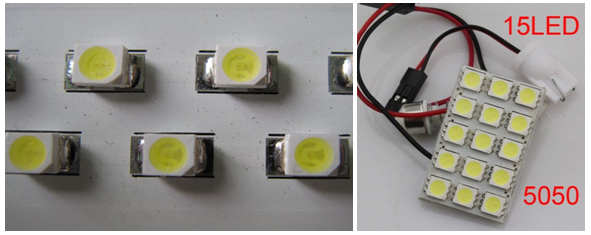
Photo 3. SMD type LEDs: SMD3528 (left) and SMD5050 (right)
- COB ( chip on Board ) - a new generation of LEDs with an improved LED structure, has a higher light output, photo 4.

Photo 4. COB type LEDs
- extra high power LEDs designed for industrial lighting, photo 5. The current consumption of such lamps can be 1 ... 10 A or more (type 5630, 5730) and power up to 1 kW.

Photo 5. Extra high power LEDs
The LED lamp consists of such components, photo 6:
- plastic diffuser (diffuser) - this is the upper part of the structure made of special plastic, which evenly scatters the light rays of the lamp;
- LED or LED module (with a large number of LEDs) - a light source. The number of LEDs in one lamp can reach several tens. The LEDs are mounted on an aluminum mounting plate;
- aluminum circuit board (heat-conducting platform), which is designed to remove heat from the chips to the radiator, providing the required temperature level for the normal operation of the LEDs. Printed circuit board installed on thermal paste (special paste with increased thermal conductivity);
- aluminum radiator - designed to remove temperature from the diodes. normal operation radiator - the key to the durability of the lamp and in particular LEDs;
- IC driver (converter) - a special electrical element that converts and aligns alternating current into permanent. The driver allows you to increase the life of the lamp. The power factor of the driver IC (power supply) must be at least 0.9. A good quality driver has protection against power surges, breakdown and overheating.
- plinth – allows you to establish reliable contact with the lamp device and the source of electricity.
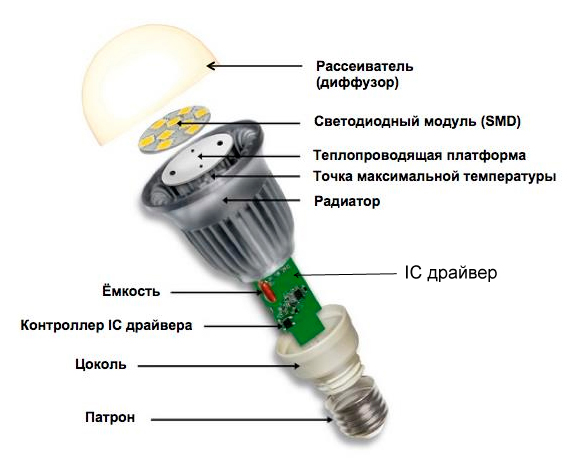
Photo 6. LED lamp device
Advantages of LED lamps
- Low power consumption (10 or more times less than the power consumption of traditional incandescent lamps).
- Long service life (within 20,000 ... 100,000 hours, this approximately corresponds to 10 ... 40 years of operation). Traditionally, lamp manufacturers give a guarantee - 2 ... 3 years.
- Low heat generation compared to incandescent lamps. In this regard, the bases of chandeliers and lamps, which are now increasingly made of heat-resistant plastic, have a much longer service life (when using incandescent lamps, the bases, as a rule, quickly become brittle and collapse from prolonged exposure to temperature).
- Resistance to mechanical influences.
- Environmentally friendly type of lamps. Does not contain or emit mercury vapor and other substances harmful to human health. There is no need for special disposal of lamps.
- Wide temperature range of lamp operation: -40…+60°С.
- Turning the lamp on and off frequently does not affect lamp life.
- Instant heating of the lamp (almost immediately).
- IN luminous flux LED lamps do not emit UV radiation.
- High light output (more than 5...8 times more than a conventional lamp) - 1 W produces 70 lm (lumens), photo 7.
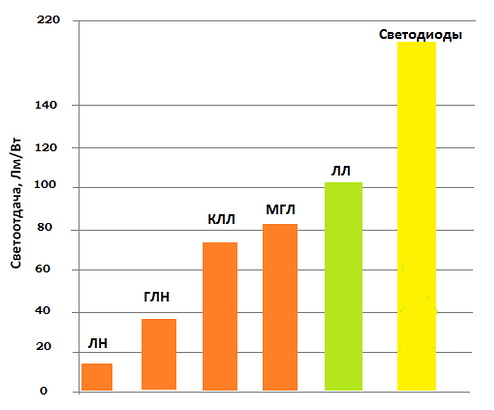
Photo 7. Comparative light output diagram various kinds lamps
- Possibility to choose the color of the visible radiation of the lamp (color temperature of the LED), photo 8. Can choose:
- warm white light, corresponds to the light from a conventional incandescent lamp (2700 ... 3000 K);
- natural white light (imitation daylight a) – 4000…4400 K;
- cold white light - 6000 ... 6500 K, photo 8a;
- any color and shade (for decorative lighting), photo 8b.
- Ability to adjust the brightness of the LEDs.
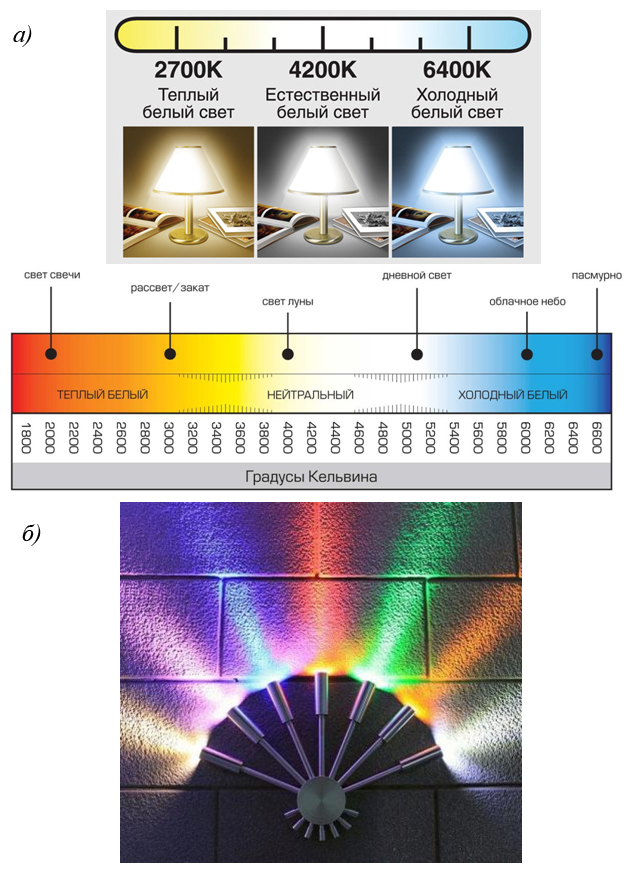
Photo 8. Choosing the color temperature of the LED: a) color temperature scale; b) decorative lighting options
Disadvantages of LED lamps
- High cost (the payback period for an LED lamp is 3…5 years).
- In cheap lamps, when using cheap elements, in particular capacitors, high-frequency flickering of light can occur. Such flickering can irritate the human retina and lead to eye disease (according to studies by Spanish scientists).
- With poor heat dissipation, the durability of cheap LED lamps is low.
- The LED shines almost in one direction, the illumination angle is up to 120°.
- Over time, the light from LEDs fades, which is especially true for low quality lamps. The rate of decrease in the intensity of the luminous flux depends on the quality of the heat sink.
Below are the comparative parameters of different types of lamps, photo 9.
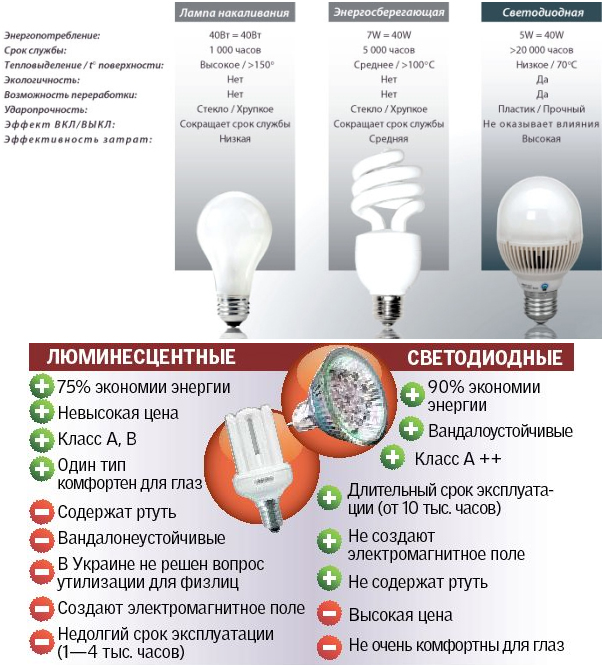
Photo 9. Comparative parameters of various types of lamps
Tips for Choosing LED Lamp for Residential Lighting
When choosing LED lamps (LED lamps) of optimal quality and characteristics, you should pay attention to following parameters:
- Light efficiency parameters. The luminous efficiency parameter must be at least 100 Lm/W. Often this parameter is not written on the lamp or box, then it can be determined by a simple calculation: the illumination (Lm (lumen)) should be divided by the lamp power, which is indicated in watts (W).
- Colorful temperature. The value of the color temperature, which is optimal for perception by the human eye and should be 4000 K. Also, the best solution for children's rooms and lighting in the evening will be lamps with a color temperature close to 3500 K ("soft white light"), photo 9.
- Lamp power. By power, one can also indirectly judge the luminous efficiency of the lamp. There are tables by which you can determine the correspondence between the power of an LED lamp and an incandescent lamp, photo 10, and, based on this, determine what power you should buy an LED lamp. Typically, the luminous efficiency of LED lamps is 8 to 10 times higher than incandescent lamps.
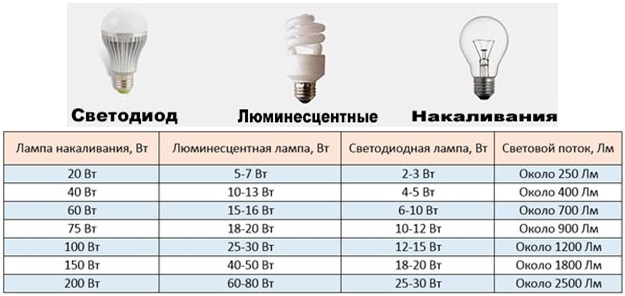
Photo 10. Comparative tables of luminous efficiency in terms of power of an LED lamp and other types of lamps
- Checking the efficiency of the heat sink. As noted above, good quality LED lamps are equipped with a heat sink, the design of which is made in such a way (the presence of ribs and spirals) to remove heat to the maximum. You can approximately determine the quality of the heat sink by the temperature of the case heating a short time after the lamp is turned on. Also, checking the quality of the lamp and its heat sink can be determined using a special device - a luxmeter. If the light meter detects a decrease in the light intensity of the lamp by more than 10% 40 minutes after switching on, then such a lamp is of poor quality and is equipped with a cheap and inefficient heat sink. Poor-quality lamps have a low indicator of luminous efficiency and durability. In the absence of a heat sink in the form of a radiator (with a lamp power of more than 4 ... 10 W or more), you should not buy LED lamps.
- Check for pulsation. High-quality LED lamps have a low pulsation coefficient of the luminous flux. You can check the degree of pulsation using a regular mobile phone - when you point the phone's video camera, stripes and flicker should not appear on the screen.
- Manufacturer. High quality LED lamps are produced by such manufacturers as: Osram (Germany), CREE (USA), Philips, Seoul Semiconductors (Korea), Nichia. There are also other manufacturers who produce quality products, but you should stop buying cheap lamps, especially Chinese ones.
In poor quality LED lamps, sapphire is used as part of the LED, which is not a reliable material. Manufacturers of high-quality products in the manufacture of LEDs use silicon carbide.
Guided by these tips, it will be possible to buy optimal quality lamps that will effectively illuminate your factories, homes, offices and suburban areas for many years.
You can save even more energy by using motion sensors -.
The publication was prepared by an expert
Konev Alexander Anatolievich
Modern LED lamps can be classified according to several criteria:
according to the purpose of the lamp;
according to the type of its construction;
by type of base;
properties of the emitted light.
By purpose, LED lamps are divided into:
lamps for the main lighting in residential premises;
lamps for local designer lighting;
lamps for outdoor architectural lighting and landscape design;
lamps for use in explosive environments;
lamps for lighting streets, parking lots, bridges, sidewalks, railway stations, etc.;
lamps for spotlights that are installed in industrial buildings and territories.

By type, depending on other properties, LED lamps are divided into:
general purpose lamps for residential and office premises;
directional light lamps for spotlights, which are applicable both for local illumination of building interiors, shop windows, advertising structures, and for landscape lighting;
linear lamps in the form of oblong tubes, to replace fluorescent lamps.
According to the type of base, there are mainly five main types:

Plinths E27, E14
A standard threaded connection found in the most ordinary incandescent lamps. This type of plinth was introduced by Edison himself, and the letter "E" is the first letter of the inventor's last name. The numbers indicate the diameter of the base in millimeters.
Today, E27, E14 bases and their other sizes are the most common types among all bases, including LED lamps. The E14 base is also called the "minion". Light bulbs with such a base usually have a candle-shaped bulb, an elongated shape, and are used mainly in wall lamps, floor lamps, and table lamps.

A two-pin connector, the pins of which have bulges at the ends, designed for swivel mounting of the lamp in the socket. Such bases have, for example, starters in old gas-discharge lamps, which were widely used in public places in the past. The letters in the name of the base indicate the following: G - pin base, U - with bulges at the ends. 10mm is the distance between the pins.
This type of base is the most electrically safe, it is convenient to use, and LED lamps with this base are usually rated for 220 volts. Mostly, lamps with such a base are those that are installed in ceiling lights (reflector LED lamps).

GU5.3 type bases, bases of the same pin family, have become widespread in recent times, when halogen reflector lamps in ceiling fixtures have become widespread. Basically, this is spot lighting mounted in plasterboard ceilings.
LED lamps with such a base came to replace with a similar base, and are easily mounted in cartridges. The holes in the cartridges for this base exactly match, the distance between the pins exactly matches the holes, and is 5.3 mm, so installation is quite simple and safe.

This base is characteristic of linear lamps in the form of tubes. As in the previous case, 13 is the distance between the pins in millimeters. Often, these are lamps for ceiling lights, which are often used to illuminate large areas shopping centers, warehouses, production workshops, and other premises where the ceiling is high enough and the area is long.
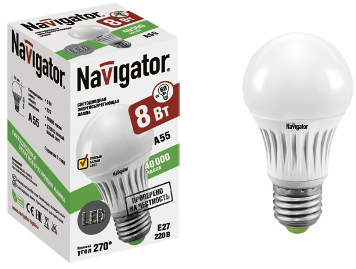
As for the labeling of LED lamps, it is similar to the labeling of compact fluorescent lamps (CFLs), and the manufacturer indicates comprehensive information about the product on the packaging. In addition to the LED inscription, indicating that the lamp is LED, other lamp parameters are also reported. Let us consider in more detail, using an example of what is indicated on the package, and what these parameters are.
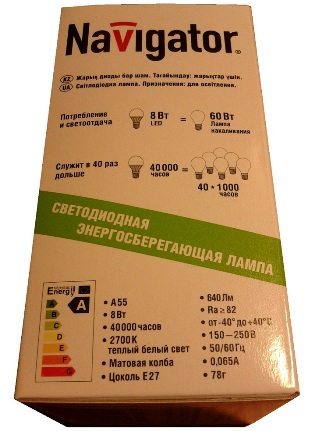
Power
The packaging must indicate the power consumed by this LED lamp from the network. As a rule, the packaging also indicates the equivalent power of incandescent lamps in terms of luminous flux, however, this equivalent parameter is given only for comparison. The real one, of those currently available for sale, is in the range from 1 to 25 W, depending on the needs of the buyer.
Comparison of LED amps with other types of lamps:
Life time
Service life in hours. This parameter may differ for different manufacturers, and according to statistics, the service life of LED lamps in normal, not extreme conditions, with high-quality mains power, can reach 50,000 hours.
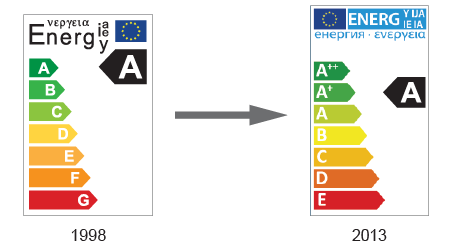
Energy efficiency class
Of course, LED lamps are very energy efficient, and the packaging is always indicated. If earlier this indicator was limited to level “A”, then with the development of energy efficient led lighting, additional classes “A +” and “A ++” appeared, indicating a significantly lower value of the ratio of power consumption to power calculated from the effective luminous flux received from this lamp.
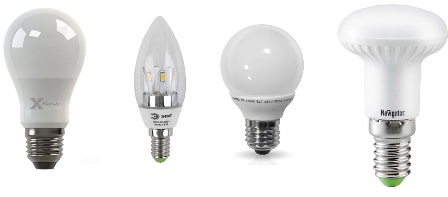
Flask type
In this example, the bulb type A55 is indicated - a standard shape, like a conventional incandescent lamp. There are other options: C35 - candle, G45 - ball, R39, R50, R63 - mirror, and others. The flask can be opaque or transparent, this is indicated on the package.
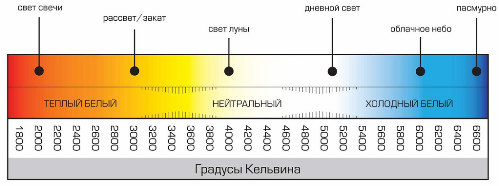
It can be different, from very warm to very cold, and more comfortable for a person is a more “warm” light, closer to yellow, as is the case with incandescent lamps. Cold light is more suitable for industrial premises, street lighting and other places where a person does not seek to get maximum comfort, and if a cold light is installed in a living room, this will adversely affect the human nervous system. This indicator must be indicated on the packaging.
Color temperature is measured in Kelvin and the ranges are labeled accordingly: warm white (2700-3200 K), neutral white or daylight (3500-4500 K), white light (4700 - 6000 K), cool white (from 6000K).
The brightness of an LED lamp, measured in Lumens. For clarity, you can use the table, and get an idea of the luminous flux that ordinary incandescent lamps give. Of course, LED lamps are able to provide the appropriate luminous flux, consuming 7-10 times less electrical energy.

Color rendering index Ra
For sunlight, this is 100, for incandescent lamps - from 90 and above, for LED - from 80 to 89. This indicator reflects how close to its natural color the body remains illuminated by this light source. A Ra value greater than 80 is generally considered quite high.
Consumption parameters
The example above shows that this LED lamp can operate at temperatures from -40 to +40 degrees Celsius, powered by AC voltage from 150 to 250 V, frequency 50/60-Hz, while the maximum (peak) current consumption will be 0.065 A.




